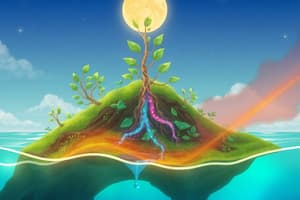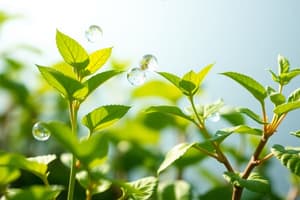Podcast
Questions and Answers
What is the main difference in nutrient and gas requirements between autotrophs and heterotrophs?
What is the main difference in nutrient and gas requirements between autotrophs and heterotrophs?
What is the main function of alveoli in mammals?
What is the main function of alveoli in mammals?
What is the main function of the vascular system in plants?
What is the main function of the vascular system in plants?
What is the transpiration-cohesion-tension theory related to?
What is the transpiration-cohesion-tension theory related to?
Signup and view all the answers
What is the main difference between open and closed transport systems in animals?
What is the main difference between open and closed transport systems in animals?
Signup and view all the answers
What is the main difference between the transport systems in plants and animals?
What is the main difference between the transport systems in plants and animals?
Signup and view all the answers
Study Notes
Nutrient and Gas Requirements
- Autotrophs and heterotrophs have different nutrient and gas requirements, with autotrophs producing their own food through photosynthesis and heterotrophs obtaining energy by consuming other organisms.
- Plant structures, such as leaves, play a crucial role in photosynthesis, with products being traced and moved throughout the plant.
- Gas exchange structures, including alveoli in mammals and leaf structure in plants, facilitate the exchange of oxygen and carbon dioxide.
- Microscopic and macroscopic structures, such as respiratory systems, are adapted to facilitate gas exchange in different organisms.
Transport Systems
- The composition of the transport medium changes as it moves around an organism, with differences in structure and function between animal and plant transport systems.
- Plant vascular systems and animal cardiovascular systems are examples of transport systems that have distinct structures and functions.
- Open and closed transport systems are found in animals, with plants having a unique vascular system.
- Comparison of transport systems can be facilitated through physical and digital models, as well as microscopic and macroscopic samples.
Studying That Suits You
Use AI to generate personalized quizzes and flashcards to suit your learning preferences.
Description
Explore the differences in nutrient and gas requirements between autotrophs and heterotrophs, and investigate structures in plants and animals related to photosynthesis and gas exchange.




